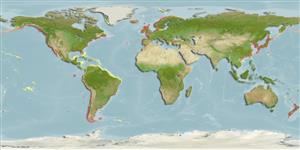Polydora cornuta Bosc, 1802
Whip mudworm| Native range | All suitable habitat | Point map | Year 2050 |

|
| This map was computer-generated and has not yet been reviewed. |
| Polydora cornuta AquaMaps Data sources: GBIF OBIS |
Изображение на Google |
No photo available for this species.
Классификация / Names народные названия | синонимы | CoL | ITIS | WoRMS
Polychaeta | Spionida | Spionidae
Environment: milieu / climate zone / пределы глубины / distribution range экология
; солоноватоводный; пределы глубины 2 - 5 m (ссылка 87155). Subtropical; 27°C - 28°C (ссылка 87155)
Distribution страны | регионы FAO | Ecosystems | места находок | интродукции
Pacific Ocean, Atlantic Ocean and the Mediterranean Sea.
Length at first maturity / Size / Weight / Возраст
половая зрелость: Lm ? range ? - ? cm
Life cycle and mating behavior половая зрелость | размножение | нерест | Eggs | Fecundity | Larvae
Основная ссылка
ссылки | координатор | соавторы
Sato-Okoshi, W. 2000 Polydorid species (Polychaeta: Spiondae) in Japan, with descriptions of morphology, ecology, and burrow structure. 2. Non-boring species. J. Mar. Biol. Ass. U.K. 80:443-456. (ссылка 1046)
Статус Красного Списка МСОП
(ссылка 130435: Version 2025-1)
Статус СИТЕС (ссылка 108899)
CMS (ссылка 116361)
Угроза для людей
Использование человеком
| FishSource |
инструменты
дополнительная информация
состав пищи
потребление пищи
хищники
ресурсы в Интернет
BHL | BOLD Systems | CISTI | DiscoverLife | FAO(Publication : search) | Fishipedia | GenBank (Геном, Нуклеотид) | GloBI | Gomexsi | Google Books | Google Scholar | Google | PubMed | Tree of Life | Wikipedia (Вперёд, поиск) | Zoological Record


